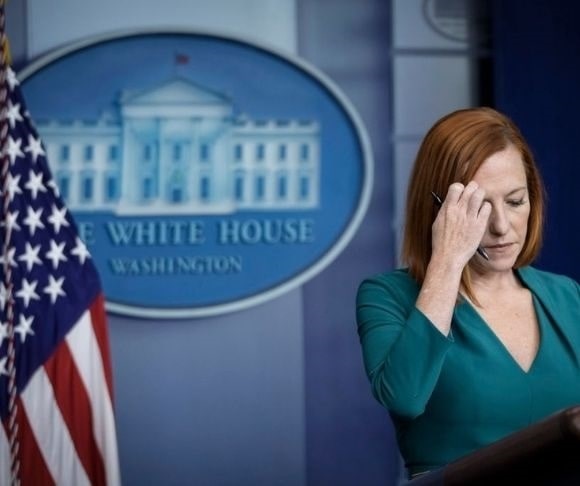As nearly 70% of Americans disapprove of the way President Joe Biden is handling inflation, the administration appears to be manufacturing a never-ending list of excuses for the root cause of the issue, even if it defies the data and common sense. This is the same playbook used by Hillary Clinton, the woman who will never become president. This time, White House Press Secretary Jen Psaki has come up with a new reason to rationalize 39-year high price inflation: Greed. It is not fiscal policies triggering a series of unintended consequences or a plethora of intensifying pressures but, rather, the insatiable rapacity of the meat industry that is cause for the escalating cost of living in the Biden economy.
Trying to Make Ends Meat
When asked if President Biden agreed with progressives who accuse “meat conglomerates” of raising meat prices at supermarkets, Psaki responded that the president and the secretary of agriculture, Thomas Vilsack, agree “the greed of meat conglomerates” have played a role in accelerating food prices over the last year. According to Psaki:
“The way American families digest inflation is by price increases and if you look from industry to industry it is a little different.
“So, for example, the president, and the secretary of agriculture, had both spoken to what we’ve seen as the greed of meat conglomerates. That is an area when people go to the grocery store and they’re trying to buy a pound of meat, two pounds of meat, ten pounds of meat, the prices are higher. That is, in his view, and the view of the secretary of agriculture, you could call it corporate greed, sure, you could call it jacking up prices during a pandemic.”

Jen Psaki (Photo by Drew Angerer/Getty Images)
Perhaps Psaki thought she was clever in her economic analysis of inflation. But the reality of the situation is far different than what the White House understands. Whether this is on purpose or just ignorance can be debated, so it is critical to examine the latest data from the Bureau of Labor Statistics (BLS) to determine if the press secretary was accurate.
A Big Missed Steak
The November consumer price index (CPI) highlighted a crucial development in the economic recovery: Higher prices are being seen across the board. From food to energy to shelter, the key indexes surged at an annualized rate last month.
Indeed, the cost of meat skyrocketed year-over-year, led by beef and veal (+20.9%), pork (+16.8%), ham (+10.7%), and chicken (+9.2%). But nearly every food item, except for potatoes, went up dramatically. Here is a list of common items consumed by the typical home and how much they climbed:
- Apples: +7.4%
- Bread: +4%
- Coffee: +7.5%
- Milk: +4.6%
- Tomatoes: +3%
Even taking food out of the equation, price inflation surged in other areas of the marketplace. Gasoline spiked 58.1%, electricity rose 6.5%, furniture and bedding advanced 11.8%, household cleaning products added 2.6%, and women’s dresses increased 8.6%.
So, sure, Psaki can blame Big Meat, but the numbers suggest she is, as usual, incorrect. Moreover, if inflation were not a serious factor and these meat companies wanted to generate massive profits and garner a greater market share, they could undercut their competitors and lower prices. This might be too much to fathom for an administration that fails to grasp basic economics.
The Wurst of Times
Why are meat prices soaring anyway? It is a perfect storm of developments that have significantly hurt the broader industry, from the cattle ranchers to the meat-packing facilities. Every step of the supply chain process bears the brunt of today’s inflationary woes, whether it is higher energy prices or the shipping container traffic jam. But labor is another component of the sticker shock consumers are enduring at the grocery store.
[memberzone align=”left”] Indeed, there is immense uncertainty in global protein markets as pandemic-induced backlogs at meat processing plants escalate. A common problem these companies face is a labor shortage. Businesses are trying to find workers to complete overnight and weekend shifts, but it has become a struggle hiring people, resulting in employers offering higher wages to clear the backlogs and satisfy demand.
Over the past year, Tyson Foods, the world’s second-largest processor and marketer of beef, chicken, and pork, has spent more than $500 million in wage increases and bonuses for its hourly frontline workers. This always makes its way to the shelf in the form of price hikes, causing households to face bigger bills when they check out at their local Kroger, Safeway, or Walmart.
Administration Tries to be Cleaver
For the last several months, after it was evident red-hot inflation was not transitory, the White House attempted to downplay the concerning trends unfolding in the post-COVID recovery. Psaki had dismissed the supply chain calamity as a “tragedy of the treadmill,” while National Economic Council (NEC) director Brian Deese purported that inflation is only high because items causing higher prices are being counted. This does not include the officials who repeated the absurdity that inflation would be short-lived. The consensus at the Oval Office is that inflation will subside ahead of the 2022 mid-term elections. How convenient. However, with deficit-financed spending not abating and specific economic trends – labor and global trade – not improving, these forecasts will more than likely be wrong, too.
~ Read more from Andrew Moran.




